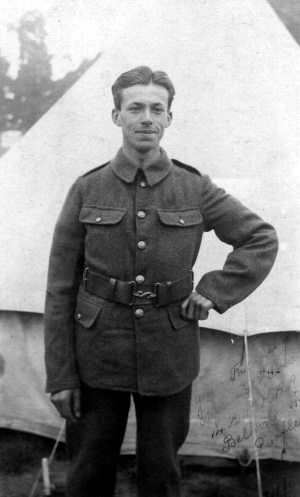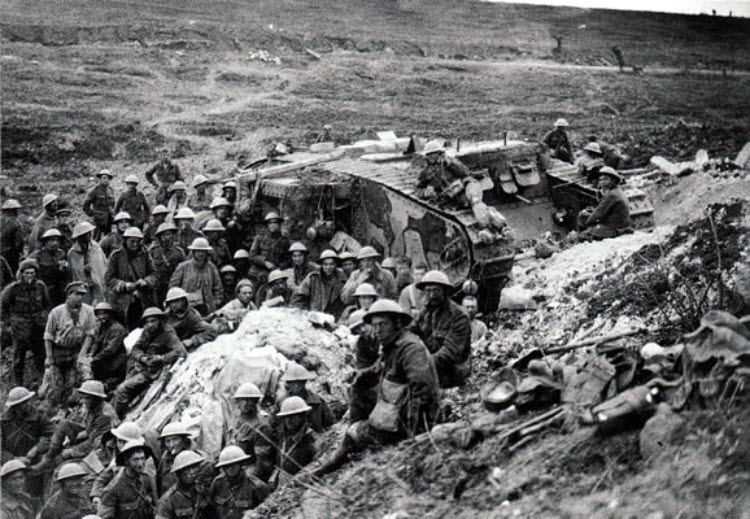
R/13906, King’s Royal Rifle Corps, 11th Battalion
George Alfred Coldbeck was born in Grewelthorpe, North Yorkshire in 1892, the third child and first son of Alfred Burton Coldbeck (born 1867) and his wife Phyllis Harriet (nee Warrior, born 1864) who married in the Ripon Registration District on the 3rd January 1885. Alfred Coldbeck was a groom and gardener living at Cross, The Hill, Masham in 1901.
Phyllis Coldbeck died in 1896 of heart disease and asthma bronchitis at the early age of 32 years, and in late 1897, Alfred (30), a jobbing gardener, married Mary Louisa Clarke (23) and they went on to have seven children. From 1891 the Coldbeck family lived in Masham, but by 1911 George Arthur, aged 18, was staying at the home at the Masham home of a tobacconist and hairdresser where he was working as a trainee hairdresser. By June 1915, George Alfred Coldbeck had left Masham and was now living at the Little Bull Yard, Ossett Common and working there as a hairdresser. At some stage he also lived at 51, Victoria Buildings, South Ossett.
George enlisted for the duration of the War on the 4th June 1915 and claimed to be 25 years of age, two years older than his true age. George was 5’ 2½” tall, weighed 100 lbs, with a 35″ chest measurement and his physical development was described as “fair.”
On the 8th June 1915, he joined the 14th (Reserve) King’s Royal Rifle Corps at Winchester, with service number R/13906. He was posted to Belhus Park, Purfleet on the 11th June 1915 until 20 September 1915 when the Corps moved to Seaford. He was promoted to paid Lance-Corporal on the 4th October 1915. He left Seaford and embarked for France on 1st December 1915 joining 11th King’s Royal Rifle Corps in the field on the 26th December 1915.
On the 1st January 1916 he reverted to Rifleman from Lance-Corporal and by the 8th February he was employed, in the field, as the Regimental Barber (paid by public). He was hospitalised for a day in early July 1916 and promoted again to unpaid Lance-Corporal on the 15th September.
On the 17th September 1916 he was wounded and the following day admitted to the field hospital with gun shot wounds to the thigh and abdomen. He died of those wounds on the 18th September 1918. George Alfred’s effects were subsequently returned to his father as next-of-kin. The effects comprised his identity disc, letters, comb, mirror, small pocket knife, photo and books. lance-Corporal Alfred Coldbeck was awarded the British, Victory and 1914-15 Star .
The 11th (Service) Battalion of the King’s Royal Rifle Corps was formed at Winchester in September 1914 as part of K2 and came under orders of 59th Brigade in 20th (Light) Division. The battalion moved to Blackdown, going on in February 1915 to Witley and then in April to Larkhill. On the 21st July 1915 they landed at Boulogne.
Lance-Corporal George A. Colbeck died during the Battle of Flers–Courcelette. Launched on the 15th September 1916, the battle went on for one week and was the third main phase of the Battle of the Somme. It is best known as the first tank battle in history, as it featured forty nine Mk I tanks (although not all of the tanks made it into battle).
Flers–Courcelette began with the objective of cutting a hole in the German line by using massed artillery and infantry attacks. This hole would then be exploited with the use of cavalry. It was the third and final general offensive mounted by the British Army during the Battle of the Somme. By its conclusion on the 22nd September, the strategic objective of a breakthrough had not been achieved; however tactical gains were made in the capture of the villages of Courcelette, Martinpuich and Flers. In some places, the front lines were advanced by over 2,500 yards (2,300 m) by the Allied attacks.1
Over the last seven days of the battle the British engaged in a series of small scale operations designed to consolidate the line, especially in the area around High Wood, where the limited advance on the 15th September had left a bulge in the new line. Heavy rain began on the 18th September, which made further offensive operations even more difficult.
The War Diary of the 11th Battalion, K.R.R.C. has the following entries for their part in the battle:
14.09.16 HAPPY VALLEY [ALBERT] We move into HAPPY VALLEY and take over a Camp from the Guards.
15.09.16 BRONFAY FARM At 5:45am we move on and bivouac near BRONFAY FARM with orders to move at 10 minutes notice.
16.09.16 TALUS WOOD At 4:45am we move on to TALUS WOOD where we bivouac. In the late afternoon we are told that we are to attack LESBOEUFS next day. At 9pm we move up to the line to take over from the Guards who had attacked in the morning and had not reached their objective. Complete ignorance of the guides sent us as to where exactly to find the Guards, made relief very difficult and a long process. To add to our difficulties we ran into a certain amount of tear gas in the low lying parts between TRONES WOOD and the LONGUEVAL – GUILLEMONT Road. The relief was complete about 4:30am. The work of deepening and improving the trenches was immediately begun.
17.09.16 TRENCHES The enemy start to bombard at 9am and continue to do so the whole day. In the afternoon we receive orders to attack the line running from T.3.a.9.1 to T.3.d.1.6. We attack on a 3 Coy front in conjunction with the 10th Bn RB and 11th Bn KRRC [the 10th Bn KRRC were in support in the FLERS line] but owing to the orderly with the orders for attack being hit, D Coy did not move up in support. The attack was a failure owing to:-
[i] insufficient barrage and that not on the German trench;
[ii] the Brigade on our RIGHT and LEFT had not reached the positions they were thought to be in and therefore unable to assist us as had been arranged;
[iii] the distance over which the Bn had to attack;
[iv] our jumping off trench being at right angles to the German trench;
[v] the overwhelming MG fire from both flanks and the front.
The Brigade retired into their original trenches with the 10th KRRC still in support in the FLERS line about T8a.
18.09.16 [i]TRENCHES It rains hard all day. By the evening the trenches are in an awful state and the men very much exhausted. Rain continues all night.

Above: British troops with a Mk.1 tank at the Battle of Flers-Courcelette, 15th – 22nd September 1916.
Lance-Corporal Coldbeck appears on the Ossett War memorial programme named as George Colbeck and also on South Ossett Roll of Honour with the name George Coldbeck of K.R.R with a date of death on the 18th September 1916 and his address as 51, Victoria Buildings.
Lance-Corporal George Alfred Coldbeck, aged 24 years, the son Alfred Burton Coldbeck and Phyllis Harriet Coldbeck, of Cross Hill, Masham, Yorks died of wounds on the 18th September 1916 during the Battle of Flers-Courcelette, a subsidiary battle during the Somme campaign. He is buried at grave reference I. D. 25. at the Grove Town Cemetery, Meaulte, 2 Somme, France. Meaulte is a village just south of Albert. From Albert head south-east on the D329 in the direction of Bray-sur-Somme.
In September 1916, the 34th and 2/2nd London Casualty Clearing Stations were established at this point, known to the troops as Grove Town, to deal with casualties from the Somme battlefields. They were moved in April 1917 and, except for a few burials in August and September 1918, the cemetery was closed. Grove Town Cemetery contains 1,395 First World War burials.
CWGC heastone photograph courtesy of Mark Smith
References: